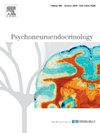Cortisol dynamics and sleep quality: The role of sex and oral contraceptive use
IF 3.4
2区 医学
Q2 ENDOCRINOLOGY & METABOLISM
引用次数: 0
Abstract
Women report poorer sleep than men, and oral contraceptive (OC) users appear to experience poorer sleep quality, in particular disrupted sleep, relative to non-users, potentially related to disruption of the circadian rhythm of cortisol. This preregistered study evaluated sleep quality and sleep disruptions and their relationship with cortisol dynamics in naturally cycling (NC) women, OC users and men. In 242 healthy participants from the Cimbi database, we first conducted cross-sectional group comparisons of self-reported sleep quality and sleep disruptions between the groups with linear regression and probabilistic index models, respectively. Second, we examined if the cortisol awakening response (CAR) mediated potential group differences in sleep quality and sleep disruptions. We show no significant differences in sleep disruptions in OC users (n = 31), or in men (n = 124) compared to NC women (n = 87). OC users reported marginally poorer overall sleep quality compared to NC women (padjusted=0.042). This difference was not mediated by the CAR. However, a lower CAR was associated with more sleep disruptions within OC users (-0.138 [-0.238; −0.039], p = 0.006) and with poorer sleep quality in men (0.24 [-0.41; −0.07], p = 0.006), but no associations with sleep were seen in NC women. In conclusion, we find modestly poorer sleep in healthy OC users compared to NC women, but no differences in sleep between NC women and men. Further, our data suggest a coupling between cortisol dynamics and sleep in OC users and men. Prospective studies are necessary to further assess the role of sex/gender differences and OC use in cortisol dynamics and sleep.
皮质醇动态和睡眠质量:性和口服避孕药使用的作用
女性的睡眠质量比男性差,口服避孕药(OC)使用者的睡眠质量似乎比非使用者差,尤其是睡眠中断,这可能与皮质醇的昼夜节律中断有关。这项预先注册的研究评估了自然循环(NC)女性、OC使用者和男性的睡眠质量和睡眠中断及其与皮质醇动态的关系。在来自Cimbi数据库的242名健康参与者中,我们首先分别使用线性回归和概率指数模型对两组之间自我报告的睡眠质量和睡眠中断进行了横断面组比较。其次,我们研究了皮质醇唤醒反应(CAR)是否介导了睡眠质量和睡眠中断的潜在组差异。我们发现,与NC女性(n = 87)相比,OC使用者(n = 31)或男性(n = 124)在睡眠中断方面没有显著差异。与NC女性相比,OC使用者报告的整体睡眠质量略差(p校正=0.042)。这种差异不是由CAR介导的。然而,较低的CAR与OC使用者中更多的睡眠中断相关(-0.138 [-0.238;−0.039],p = 0.006),男性睡眠质量较差(0.24 [-0.41;−0.07],p = 0.006),但在NC女性中未见与睡眠相关。综上所述,我们发现健康的OC使用者与NC女性相比睡眠稍差,但NC女性和男性之间的睡眠没有差异。此外,我们的数据表明,皮质醇动态与睡眠之间存在耦合。有必要进行前瞻性研究,以进一步评估性别/性别差异和OC使用在皮质醇动态和睡眠中的作用。
本文章由计算机程序翻译,如有差异,请以英文原文为准。
求助全文
约1分钟内获得全文
求助全文
来源期刊

Psychoneuroendocrinology
医学-精神病学
CiteScore
7.40
自引率
8.10%
发文量
268
审稿时长
66 days
期刊介绍:
Psychoneuroendocrinology publishes papers dealing with the interrelated disciplines of psychology, neurobiology, endocrinology, immunology, neurology, and psychiatry, with an emphasis on multidisciplinary studies aiming at integrating these disciplines in terms of either basic research or clinical implications. One of the main goals is to understand how a variety of psychobiological factors interact in the expression of the stress response as it relates to the development and/or maintenance of neuropsychiatric illnesses.
 求助内容:
求助内容: 应助结果提醒方式:
应助结果提醒方式:


